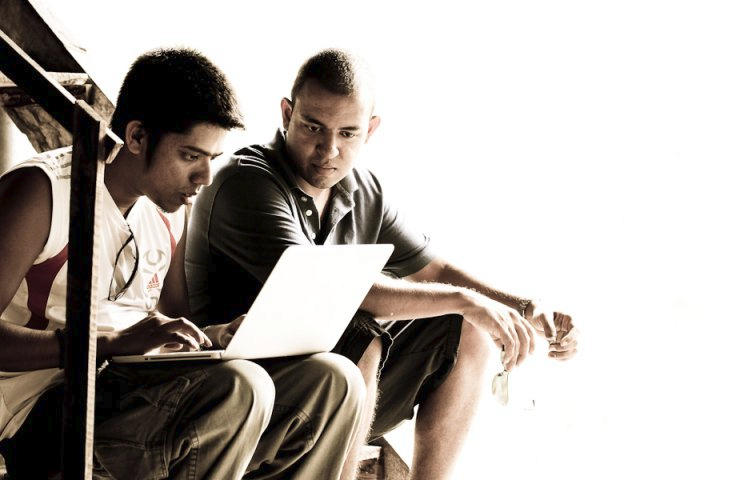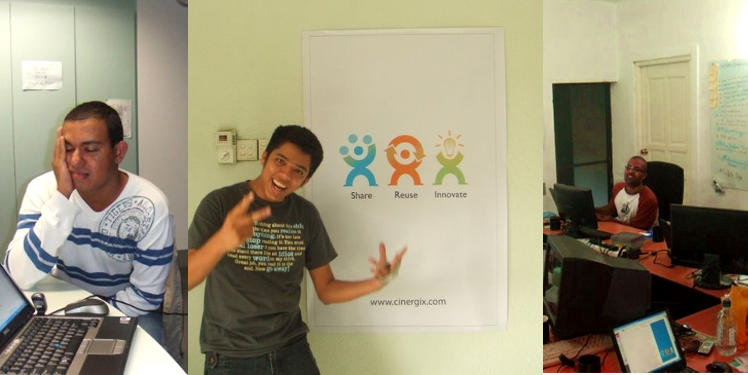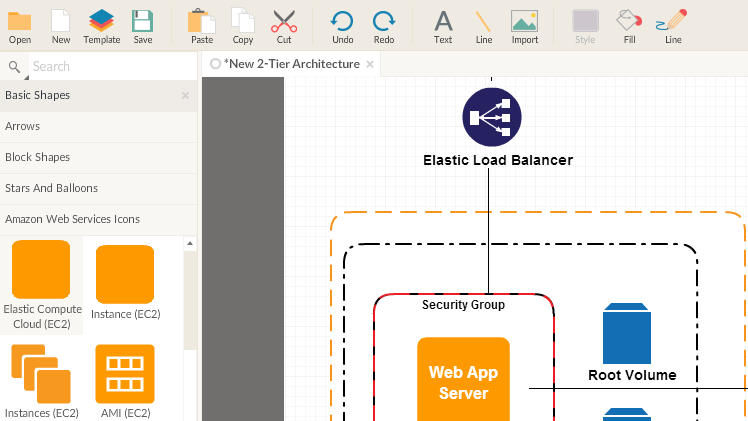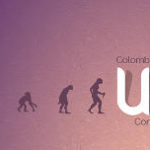Sri Lankan and Australia mix in odd places. Education. Immigration. Cricket. That second cousin, twice removed, who Skypes every Wednesday. A sizeably set of industries with large commercial interests in the other country.
And then there’s Cinergix: a Sri Lankan company registered in Australia (or an Australian company working mostly out of Sri Lanka – whichever you prefer). Cinergix’s software, a diagramming tool called Creately, is used by PayPal, Ebay, Amazon, IBM, Nat Geo, Google, Adobe, and even NASA.
They’re competing in a global market with locally-built software, and by all accounts, they’re doing a fine job of it. It’s not every company that can list as their customers the people who put the first man on the moon.

But to tell their story, one must start with Visio.
Visio, or more accurately, Microsoft Visio, has a long history. Put it this way: there was a company called Axon Corporation back in 1989. They renamed to Shapeware in 1995, and then put out their first product: Visio, a diagramming tool (they also renamed themselves to Visio later on). In 2000, Microsoft bought them for $ 1.5 billion in stock. Visio, rebranded under the Microsoft name, proved massively popular – people used it to map out everything from random brainstorms to databases to business processes.
But ten years ago, if someone had approached the Visio team then and told them that someone would come along and steal their thunder, they probably wouldn’t have believed it. Yet people did. Gliffy. Inkscape. Draw.io. Lucid Software. Google.
Cinergix.
In 2008, Cinergix unveiled Creately, their web-based diagramming software, in tech startup central – Silicon Valley. Nobody had seen these guys before. They were unknown even in Sri Lanka – a bunch of coders hacking out of a seedy, run-down house in Borella.
And they were a hit. A year later, they rolled out Creately to the public. Since then, with no sales pitches (other than the text on their website) and none of the usual contract-hunting, they’ve racked up an impressive global customer base – purely off the strength of a free-to-try web app, a well-aimed bit of press publicity, and a lot of work.
MEET THE PLAYERS
Creately, and the team behind it, lives in Orion City, Dematagoda. About a hundred feet behind the big Virtusa building is a right turn leading to what Orion calls “the Nest”. In here are what one might call “new blood” – lean companies that mostly work on their own products, as opposed to the outsourced engineering work that make up the biggest chunk of Sri Lanka’s software industry.
Somewhere in here is Chandika Jayasundara and Hiraash Thawfeek, the CEO and CTO of Cinergix. Both Chandika and Hiraash are people I’ve met before, if only briefly, at the Colombo Javascript hackathon. Chandika is a soft-spoken individual, impeccably polite and vaguely explanatory. He’s been named in Echelon Magazine’s 40 under 40, a list of some of 2014’s biggest “risk takers and rule breakers”. Hiraash is a stark contrast; a lean firebrand who stays aloof, almost disinterested in small talk, until he starts talking about Creately; then a light goes on behind his eyes.

The story starts with Chandika and Hiraash in D.S. Senanayake College, in the early 90’s. Back then, they had an active school computer society. With few teachers in the entire country capable of teaching the subject, the students were left to their own devices. Which meant that a hard core congregated and began hacking. Like MIT’s Tech Model Railroad Club, which spawned the first generation of hackers, the D.S. Senanayake College Computer Society was a small hotbed of creative geek activity. Chandika and Hiraash quickly found their way to the exhibition circuit, showing off neat things that they’d come up with.
Hiraash, in particular, found great success here. By the time he finished school, he’d build a mapping application for Colombo – this was before Google Maps existed – and racked up quite a number of university-level awards. While Chandika went on to the University of London, Hiraash snagged his first job, as an associate at a brand-new startup.
Hiraash’s enthusiasm for this first steep still shines through: his face lights up with a huge smile as he discusses this piece of his past. “It was amazing, because all this time you’ve been writing software, and now you’re writing software that people actually use!” he exclaims.
All told, he had a good run on the bleeding edge – when he switched to Zone 24/7 a year later, he was working with smart cards, fingerprint scanners and SIMs – everyday tech that, back in the 90’s, was practically science fiction to a large part of the world.
Meanwhile, Chandika had graduated from the University of London and made a beeline for Virtusa. He’d already started a company called Xeont; they built websites, but it didn’t quite work out. Virtusa was a two-year stint for Chandika; it was one of the best companies he’d ever seen, but eventually, he packed up and left for Australia for his Masters degree.
IDEAS, CHECK. PEOPLE, CHECK
The story picks up again in 2007. Chandika found himself working, with a few other senior researchers, on a program that could coment on images. It was meant for collaborative learning, but Chandika started using it to make memes out of people’s Facebook profile pictures. People loved it.
This evolved into something else: diagramming.
“Day in and day out, you see this,” says Chandika, referring to the everyday art of diagrams. “I realized that we apply a great deal of knowledge when we create a diagram. Take a network diagram: a lot of thinking goes into how it’s set up. But on the final output, all that expert knowledge is lost, ironed out, and you end up with a simple image that tells you what’s connected to where.”
Chandika spoke to Nick Foster, who would end up becoming Cinergix’s COO, Hiraash, and Chiranjit Singh, another friend. They realized that they could remove a great deal of the planning overhead by bringing in computerized, expert knowledge into the process of making a diagram. “Like a spellchecker for visual design” Chandika explains. The idea was to automate part of the creation process, so as to make life easier. They called it Knowledge Objects. It was a very complex design, and it got them enough recognition to secure a bit of funding.
“That was our proof of concept, our validation,” says Chandika. “Hiraash was at Zone. Another friend, Dumindu, was at WSO2. We Skyped. We talked. And we decided to take the plunge.”
“You know, when all of this happened, I was shuttling back and forth between the US and Sri Lanka,” adds Hiraash. “We threw around names, code…and then in 2008, I was left with a tough choice: keep doing what I did or join the guys and work on our own company. I thought to myself ‘It’s not every day, right?’ and packed up and left to join Chandika.
“Our first place was this really, really seedy place in Borella. We wanted a cheap place to hack; we got it. It was right next to a shady massage parlour. We’d walk around in shorts and ignore everything except the code and each other. We were coders. And janitors. And whatever else we had to be.”

Chandika laughs. “We wanted a massive whiteboard; we were so cheap that we went to Kotahena, got a huge piece of plywood, and got a guy to paint it.”
Cinergix had a problem: they were competing with Microsoft. They had a team – a handful of people in a run-down place in Borella, one person in Singapore, another in Australia. They had a product. That was all.
In Chandika’s words, “We were nobodies. We knew we were good; that was just about it.”
So in 2008, they applied to the Fall event of Demo. Demo was the place to launch. From 1987 to 2010, some of the best products had launched there – Java and Skype being just two of them. The top media and the top tier of the tech industry sat in. Every year, about a thousand companies applied; only seventy got in.
“Walt Mossberg was having coffee right next to our table!” grins Chandika, referring to the iconic journalist christened “The Kingmaker” by Wired.
They tried to pitch to Mossberg, but he waved them away. Then, with a frenzied spurt of last-minute coding, they aced their Demo pitch. “They were like ‘You guys are good to go’,” says Hiraash, “And that was amazing. We’d also applied for the TechCrunch50 – TechCrunch and Demo are rivals – and we sent Jason Calacanis* an email saying ‘We got selected to Demo, are you interested?’ They called us, but didn’t give us anything official, so we launched at Demo. They were bitching about TechCrunch at Demo: I remember someone on stage saying that Micheal Arrington was as good a mentor for business as Britney Spears for musicians. We went and had a look at TechCrunch as part of the audience.”
*Jason Calacanis eventually had a massive falling-out with TechCrunch.
THEY WANT TO DRAW
What Cinergix launched at Demo that fall was not what they have now. Hiraash heads over to YouTube, finding an old video about the app. Creately works by giving each object a certain amount of knowledge. Each object can communicate with the other, with connectors actually linking objects rather than just visually charting something. He shows me this by building a crude network map, dragging and dropping routers, an ISP and a bunch of computers onto the chart. He links the computers to the router by drawing a line between them. As soon as the routers are linked to the ISPs, they – and the computers attached to them – change their status. They’re now connected to the Internet.
“Knowledge Objects understand how to communicate with each other,” he explains. “It wasn’t just a drawing platform. Objects dynamically change based on their connections, their interactions and so on. The problem is we didn’t really have the best representation of this. We couldn’t show this off very well.”
“And we had hardware players like Samsung who wanted to use this for different purposes,” says Chandika. “People just wanted to draw.”
They went back to the drawing board. Their initial thoughts were to get experts in different fields to encapsulate all the data they’d need into the objects. But that was a task of monumental scale – they realized they’d need a 100-man team with ten PhDs customizing the platform for each and every niche, and it would never be done.
So they thought back to the idea of diagramming itself.

“A lot of people secretly hate diagramming. They don’t want to draw, they HAVE to draw; all they want to do is get this part of the documentation done and over with. From that moment, we were all about making life easier for these people.”
As Hiraash runs me through the product as it is today – a freely accessible, Flash/Flex-based web app – Chandika talks about the how and the why.
“Every company is different. We choose to focus on one thing – making our product easier. It’s not about adding n+1 features – but if we shave off half a second off the time you take to make a pretty flowchart, we’ll do it. It’s about creating something clean and beautiful that helps people be more productive.
“A lot of people, when they start a company or a product, don’t see the value of focusing on a single problem. Being a product company is not about solving the adjacent problem. It’s about solving this one problem as best as you humanly can. That’s how you get love from your users.”
THE LAST WORDS: ORION AND BEYOND
But enough philosophy; how does Cinergix operate?
Chandika is close-mouthed about their finances and the investors involved. On an operations front, they’re broadly split into two camps: products and marketing. On the marketing front, they’ve got “about 800,000 people using our product, and honestly, we haven’t sold to a single one of them.”
“You didn’t have to pitch to NASA?” I ask.
But no, apparently, they didn’t. They believe that in the old saying – that if you build it, they will come. Nevertheless, they’re the first people I’ve seen who trust their product enough to not market it. Not a lot of companies can brag about having 800,000 customers without a single pitch.
As for Orion City, that is a humorous necessity: despite their success, nobody took them seriously. Sri Lanka’s shirt-and-tie culture gave them a rap on the knuckles.
“We were hanging out in shorts and trying to interview people and it didn’t work,” recalls Hiraash. “At some point we started wearing shirts for interviews and then people actually started showing up for work the next day. We then moved to Orion, because nobody would really come and work at Borella. Some things you want to swim upstream against: some things you don’t.
“One thing is that we’re extremely flexible. Sometimes you start doing something and you realize you could improve it even further if you drop something, and we can do that, because we’re a small company. We like keeping an open culture and keep the structure flat. Sometimes people take a nap in the middle of the day and that’s perfectly fine.
The important thing is that people have ownership of the things they want to do.”

And as for the future? They want tighter integration into Google services. The app is on Flash; they want to move away from that. They want to be on mobile. They want to get people in every local university using Creately for every little thing.
They have plans.







Wonderful story. very inspiring!
Nothing to be surprised about… the duos I know are go getters with a world class vision. Inspiring story!!
Great Story, happy to see sri lankan Startup Growth & Going to Global market
Great guys !!!. This shows SL has talent
All the best chandika
Very inspiring story and thank you Yudhanjaya for this great write up. Kept me captivated to the end.
GREAT is not the word! Very proud of YOU two.
Keep the SL flag flying!
Ooooops! missed on some thing, sorry….
Now strive to be THE greatest …. wish you akk THE best!
Happy to see this guys. Make SL proud. Good luck!